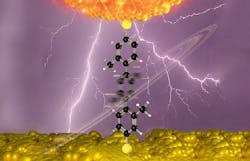Organic switchable molecules could replace silicon-based components
A research team led by physicists at the Technical University of Munich (TUM; Munich, Germany) has developed molecular nanoswitches that can be toggled between two structurally different states using an applied voltage. They can serve as the basis for a pioneering class of devices that could replace silicon-based components with organic molecules. The work is detailed in a paper in the Journal of the American Chemical Society.
RELATED ARTICLE: Photo-switchable molecules could lead to drugs controlled by light
The development of new electronic technologies drives the incessant reduction of functional component sizes. In the context of an international collaborative effort, a team of physicists at TUM has succeeded in using single molecules as switching elements for light signals. "Switching with just a single molecule brings future electronics one step closer to the ultimate limit of miniaturization," says nanoscientist Joachim Reichert from the TUM Physics Department.
The team initially developed a method that allowed them to create precise electrical contacts with molecules in strong optical fields and to address them using an applied voltage. At a potential difference of around one volt, the molecule changes its structure: It becomes flat, conductive and scatters light. This optical behavior, which strongly depends on the structure of the molecule, is quite exciting for the researchers because the scattering activity--Raman scattering, in this case--can be both observed and, at the same time, switched on and off via an applied voltage.
The researchers used molecules synthesized by a team based in Basel and Karlsruhe. The molecules change their structure in a specific way when they get charged. They are arranged on a metal surface and contacted using the corner of a glass fragment with a very thin metal coating as a tip. This serves as an electrical contact, light source and light collector, all in one. The researchers used the fragment to direct laser light to the molecule and measure tiny spectroscopic signals that vary with the applied voltage.
Establishing reliable electric contacts between individual molecules is extremely challenging from a technical point of view. The scientists have now successfully combined this procedure with single-molecule spectroscopy, allowing them to observe even the smallest structural changes in molecules with great precision.
One goal of molecular electronics is to develop novel devices that can replace traditional silicon-based components using integrated and directly addressable molecules. Thanks to its tiny dimensions, this nanosystem is suitable for applications in optoelectronics, in which light needs to be switched by an electrical potential.
SOURCE: TUM; https://www.tum.de/nc/en/about-tum/news/press-releases/detail/article/34665/

Gail Overton | Senior Editor (2004-2020)
Gail has more than 30 years of engineering, marketing, product management, and editorial experience in the photonics and optical communications industry. Before joining the staff at Laser Focus World in 2004, she held many product management and product marketing roles in the fiber-optics industry, most notably at Hughes (El Segundo, CA), GTE Labs (Waltham, MA), Corning (Corning, NY), Photon Kinetics (Beaverton, OR), and Newport Corporation (Irvine, CA). During her marketing career, Gail published articles in WDM Solutions and Sensors magazine and traveled internationally to conduct product and sales training. Gail received her BS degree in physics, with an emphasis in optics, from San Diego State University in San Diego, CA in May 1986.
